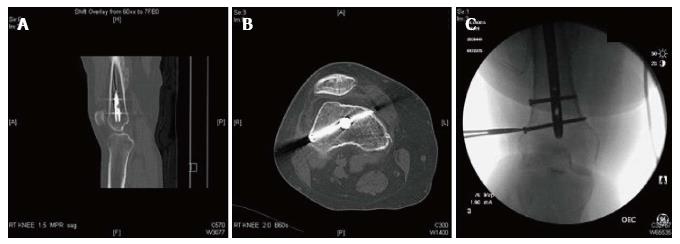Copyright
©The Author(s) 2017.
World J Orthop. May 18, 2017; 8(5): 379-384
Published online May 18, 2017. doi: 10.5312/wjo.v8.i5.379
Published online May 18, 2017. doi: 10.5312/wjo.v8.i5.379
Figure 1 Preoperative imaging of femoral nail.
A 380 mm × 11 mm Synthes trochanteric femoral nail was in place from prior and now well-healed femoral neck fracture. Two 5 mm diameter distal locking screws were used. The distal-most locking screw was placed in the distal femur approximately 20 mm superior to the trochlear notch and oriented from posterolateral to anteromedial, in close proximity to the posterlateral femoral cortex and planned femoral tunnel. A: Sagittal; B: Axial CT images; C: Intraoperative fluoroscopic radiograph. CT: Computed tomography.
Figure 2 Algorithm for anterior cruciate ligament reconstruction with anteromedial portal femoral drilling and distal femoral hardware.
Preoperative planning should guide femoral tunnel trajectory and size. Each step of femoral tunnel preparation may be performed under fluoroscopic guidance to avoid contact with existing hardware. Hardware obstruction is most likely to occur during Endobutton drilling. ACL: Anterior cruciate ligament.
Figure 3 Preoperative and postoperative imaging of distal femoral hardware.
Anterior cruciate ligament (ACL) reconstruction required removal of existing distal femoral locking screw located approximately 2 cm superior to the intercondylar notch adjacent to posterior femoral cortex and oriented from posterolateral to anteromedial. A: Preoperative Coronal X-ray; B: Postoperative Coronal X-ray; C: Preoperative Sagittal X-ray; D: Postoperative Sagittal X-ray.
- Citation: Lacey M, Lamplot J, Walley KC, DeAngelis JP, Ramappa AJ. Technical note: Anterior cruciate ligament reconstruction in the presence of an intramedullary femoral nail using anteromedial drilling. World J Orthop 2017; 8(5): 379-384
- URL: https://www.wjgnet.com/2218-5836/full/v8/i5/379.htm
- DOI: https://dx.doi.org/10.5312/wjo.v8.i5.379











